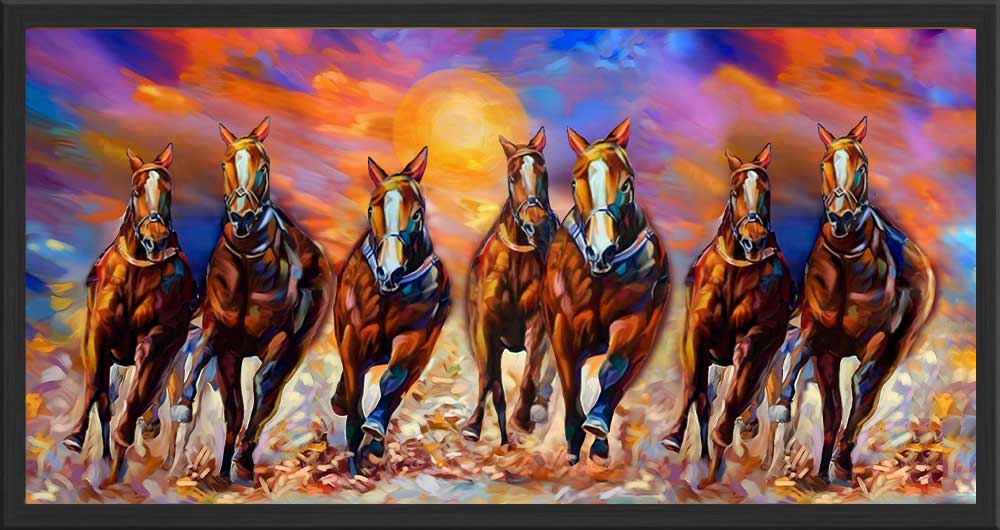
The Seven Horses Painting and Vastu Shastra: Harnessing Positive Energy in South and East Directions
The Seven Horses Painting and Vastu Shastra: Harnessing Positive Energy in South and East Directions. Vastu Shastra, an ancient Indian science of architecture and design, emphasizes the significance of spatial arrangements to channel positive energy and prosperity within a living space. One of the popular Vastu recommendations involves the placement of a painting depicting seven horses, a symbol of success, fame, and progress. According to Vastu Shastra, the direction in which this painting is placed can amplify its positive effects, particularly when positioned in the south or east direction.
Understanding the Symbolism of the Seven Horses Painting
The seven horses painting is a representation of strength, power, and rapid progress. In Hindu mythology, horses symbolize energy, vitality, and mobility. The painting typically features seven galloping horses, signifying progress and success in seven dimensions of life - career, finance, health, relationships, education, fame, and power. It is believed that placing this painting in specific directions can enhance the positive energy associated with these aspects.
The Significance of South and East Directions in Vastu Shastra
In Vastu Shastra, each direction is associated with specific energies and elements, influencing different aspects of life. Here's a brief understanding of the significance of the south and east directions:
South Direction: The south direction is associated with fame, recognition, and success. It represents the element of fire and is considered auspicious for careers and personal growth.
East Direction: The east direction is linked to new beginnings, growth, and knowledge. It symbolizes the element of air and is associated with academic achievements, spirituality, and overall progress.
Placing the Seven Horses Painting in the South Direction
Placing the painting of seven horses in the south direction aligns with the symbolism of progress and success. Here are some guidelines for optimal placement:
Ensure Visibility: Hang or position the painting in such a way that it's easily visible from the main entrance or the central area of the house. This promotes a constant reminder of progress and achievement.
Level of Placement: Ideally, the painting should be hung at eye level. Avoid placing it too high or too low, as this can disrupt the energy flow.
Clean and Well-Maintained: Keep the painting clean and well-maintained, ensuring that it remains visually appealing and continues to radiate positive energy.
Placing the Seven Horses Painting in the East Direction
Placing the painting in the east direction aligns with the symbolism of growth and knowledge. Here are some guidelines for optimal placement:
Morning Light: Position the painting in a location where it can receive the morning sunlight. This signifies new beginnings and infuses the painting with positive energy.
Clean and Uncluttered Space: Place the painting in a clean, clutter-free area to allow the energy to flow freely and positively impact the surroundings.
Facing Inward: Ensure that the painting is facing inward into the living space, not towards a wall or an outer boundary. This encourages the flow of positive energy into the home.
Conclusion
According to Vastu Shastra, placing the seven horses painting in the south or east direction can harness positive energy and enhance success, progress, and growth in various aspects of life. Adhering to Vastu principles while positioning this painting can create a harmonious living environment, promoting prosperity and well-being. As always, individual beliefs and practices may vary, so it's essential to choose what resonates best with you and your living space.
Absolutely! Let's provide a Q&A section to address potential questions readers might have about the topic.
Q&A
Q1: Can the painting of seven horses be placed in any other direction apart from south and east for positive effects according to Vastu Shastra?
A1: While the south and east directions are considered auspicious for placing the seven horses painting in Vastu Shastra, it's important to note that other directions may have different effects. For instance, placing the painting in the north can symbolize career growth, while placing it in the west can represent financial stability. However, it's recommended to consult a Vastu expert for personalized advice based on your specific circumstances.
Q2: How do I choose the right size for the seven horses painting?
A2: The size of the painting can vary based on the available space and personal preference. However, it's essential to ensure that the size is proportionate to the wall or area where it will be displayed. The painting should be large enough to be easily visible and make a positive visual impact without overwhelming the space.
Q3: Are there any specific colors or styles recommended for the seven horses painting in Vastu Shastra?
A3: Vastu Shastra does not prescribe specific colors or styles for the seven horses painting. However, it's advisable to choose colors that resonate with you and complement the overall color scheme of the room. Traditional colors like gold, red, and blue are often associated with prosperity and success and could be considered. Additionally, selecting a style that aligns with your aesthetic preferences and blends well with the room's decor is important.
Q4: Can the painting be placed in a workplace or office for success in business?
A4: Yes, placing the seven horses painting in the south or east direction in a workplace or office can be beneficial according to Vastu Shastra. It can promote success, progress, and recognition in business. The same guidelines for placement in a residential space apply to an office setting, ensuring it is visible, well-maintained, and positioned appropriately.
Q5: Is there a specific day or time to hang the seven horses painting for maximum effectiveness according to Vastu Shastra?
A5: In Vastu Shastra, it's generally considered auspicious to hang or place the painting during a favorable time, such as during sunrise or during an auspicious astrological period. However, the specific day or time may vary based on individual beliefs and practices. It's advisable to choose a day and time that holds personal significance and positivity for you.

Comments : (0)